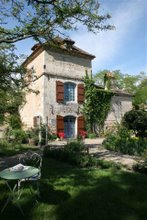To banish the habitual February blues, we cook.
We write about cooking.
We invite friends to eat.
“Seen through the cool lens of low winter light
we can find a certain inspiration
Inspired by her invocation to focus, to celebrate the simplistic choices, and find inspiration at hand, I remember this photograph I took at the winter marché au gras at Samatan.
After the overdose of duck, duck, goose…and their delicate livers- the soup.
Sometimes less is more…interesting.
She is inspiration—for a winter soup, a satisfying gratin, a rich garbure.
Of course, I bought it all. The cabbage, the squash, the snowy bunch of turnips, shallots and garlic. My money in her hand, Madame could now go home, certainly back to her own warm kitchen as I would return to mine.
Five simple winter icons=a wonderful winter meal.
No recipe is necessary. But this is what I did.
Cabbage- chop in large wedges. Blanch in salted water then drain.
Squash- peel and seed, cut into ice cube-sized pieces.
Turnips- cut off tops and wash, then slice finely (chiffonade); peel and quarter the roots.
All the shallots and one head Garlic- peel and leave cloves whole.
In the bottom of a heavy pot that has a tight fitting lid, melt two tablespoons of duck fat (remember we were at the foie gras market!). Then in layers, place the squash cubes, the cabbage wedges, and the turnip roots and greens. Stud the shallots and garlic cloves into the vegetables. Salt, pepper, and add two bay leaf and some thyme- winter aromatics. Just enough good water (no chlorinated tap water please) to barely cover the vegetables. (Think of it as a very court bouillion.) DO NOT STIR! Shake the pan gently for time to time when cooking.
Simmer on medium high heat until it is steaming nicely (15-20 minutes), then lower heat and cook slowly until all the vegetables are fork tender and easily crushed. A Gascon farmwife would have stuck in a leg of duck confit, an old ham bone, a fist full of white beans. You can, too. Or cook some thick-sliced bacon as an afterthought and place it on top of the vegetables to soften and enriche the pot likker. This is the winter garden in the ...pot.
My own Potager* lies sleeping under a cover of fallen weeds and composting hay and manure from the neighboring farm. The Gascon mud, clay thick and slippery, demands patience until late April; once dry enough to plant it rewards the pantry with a fertile vengeance. In the meantime, these winter months, I forage for some leftover roquette, a few straggler leeks, and enough mint to make a ‘Gascon julep’- an armagnac hot toddy with mint and honey.
What a good idea, as warm and soul comforting as soup. Eat the vegetables for lunch; drink the julep for afternoon tea.
*The french word Potager refers to the soup cook who also tended the vegetable garden for said soup or potage.








1 comment:
Is THAT how you say it??
Post a Comment